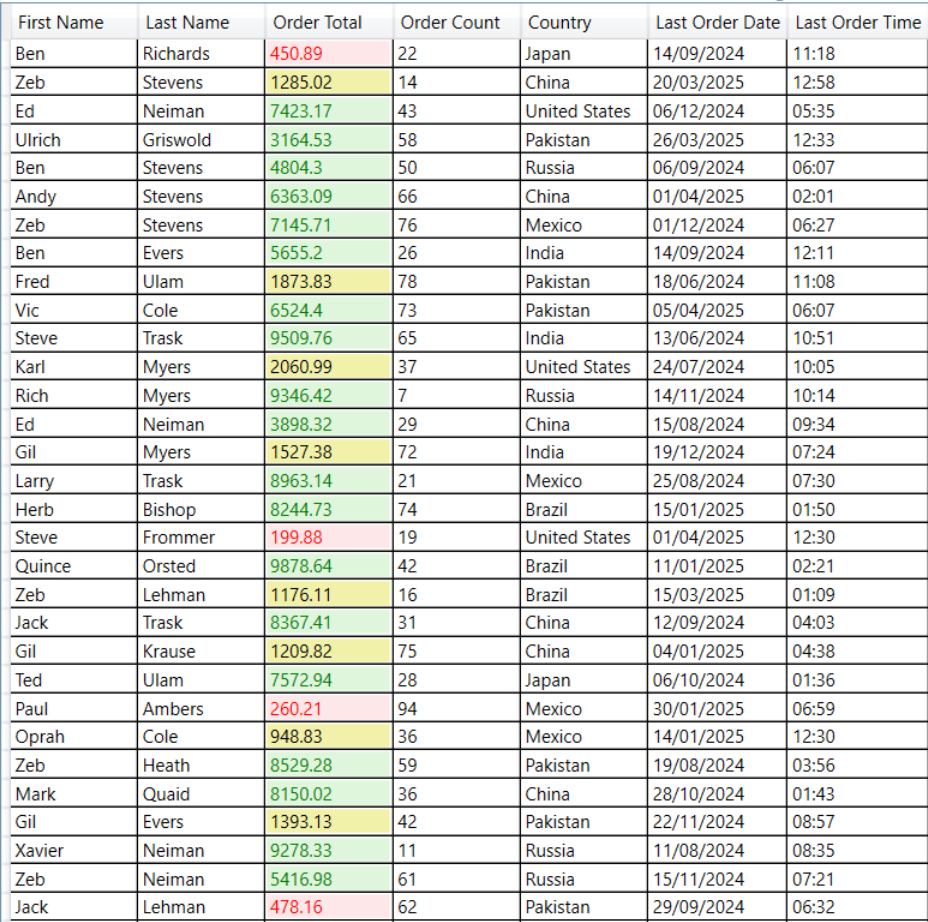How to integrate Rules Manager with DataGrid
This is a step-by-step guide for applying conditional formatting to Microsoft DataGrid by integrating the Rules Manager control.

Set Up Application
- Create a WPF application
- Drag and drop DataGrid and Rules Manager on the form
- Bind the data using ItemsSource property
Define Value Converters
Use the following code to implement two value converters.
CountryConverter
DataGridValuetoBrushConverter
<local:CountryConverter x:Key="CountryConverter"/> <local:DataGridValueToBrushConverter x:Key="valueConverter" />
The CountryConverter displays a readable country name instead of a numeric ID whereas the DataGridValuetoBrushConverter converts a data value into a brush for cell styling.
Integrate Rules Manager
Use the following code to integrate Rules Manager with C1DataGrid and add/edit the rules.
<c1:C1RulesEngine x:Key="rulesEngine" RulesChanged="C1RulesEngine_RulesChanged">
<c1:RulesEngineSegmentsRule Ranges="[OrderTotal]">
<c1:RulesEngineSegment Value="500.00">
<c1:RulesEngineStyle Background="#FFFDE7E9" Foreground="Red"/>
</c1:RulesEngineSegment>
<c1:RulesEngineSegment Value="3000.00">
<c1:RulesEngineStyle Background="#FFF2F1A9" Foreground="Black"/>
</c1:RulesEngineSegment>
<c1:RulesEngineSegment>
<c1:RulesEngineStyle Background="#FFDFF6DD" Foreground="Green"/>
</c1:RulesEngineSegment>
</c1:RulesEngineSegmentsRule>
</c1:C1RulesEngine>
Use the following code to apply cell styling based on rules applied.
<DataGrid x:Name="grid" AutoGenerateColumns="False" Grid.Column="0" SelectionChanged="grid_SelectionChanged">
<DataGrid.Columns>
<DataGridTextColumn Binding="{Binding FirstName}" Header="First Name"/>
<DataGridTextColumn Binding="{Binding LastName}" Header="Last Name"/>
<DataGridTextColumn Binding="{Binding OrderTotal}" Header="Order Total"/>
<DataGridTextColumn Binding="{Binding OrderCount}" Header="Order Count"/>
<DataGridTextColumn Binding="{Binding CountryId, Converter={StaticResource CountryConverter}}" Header="Country"/>
<DataGridTextColumn Binding="{Binding LastOrderDate, StringFormat={}\{0:dd/MM/yyyy\}}" Header="Last Order Date"/>
<DataGridTextColumn Binding="{Binding LastOrderDate, StringFormat={}\{0:hh:mm\}}" Header="Last Order Time"/>
</DataGrid.Columns>
<DataGrid.CellStyle>
<Style TargetType="DataGridCell" BasedOn="{StaticResource {x:Type DataGridCell}}">
<Setter Property="Background">
<Setter.Value>
<MultiBinding Converter="{StaticResource valueConverter}" ConverterParameter="Background">
<Binding RelativeSource="{RelativeSource Self}" />
<Binding RelativeSource="{RelativeSource Mode=FindAncestor, AncestorType=DataGrid}" />
<Binding Source="{StaticResource rulesEngine}" />
</MultiBinding>
</Setter.Value>
</Setter>
<Setter Property="Foreground">
<Setter.Value>
<MultiBinding Converter="{StaticResource valueConverter}" ConverterParameter="Foreground">
<Binding RelativeSource="{RelativeSource Self}" />
<Binding RelativeSource="{RelativeSource Mode=FindAncestor, AncestorType=DataGrid}" />
<Binding Source="{StaticResource rulesEngine}" />
</MultiBinding>
</Setter.Value>
</Setter>
</Style>
</DataGrid.CellStyle>
</DataGrid>
Use the following code to add a collapsible panel using C1Expander to show the Rules Manager control.
<c1:C1Expander Header="RulesManager" ExpandDirection="Left" ExpandIconAlignment="Left" HorizontalContentAlignment="Right" BorderThickness="0" Grid.Column="1">
<c1:C1RulesManager x:Name="rulesManager" Engine="{StaticResource rulesEngine}" Width="400"/>
</c1:C1Expander>


